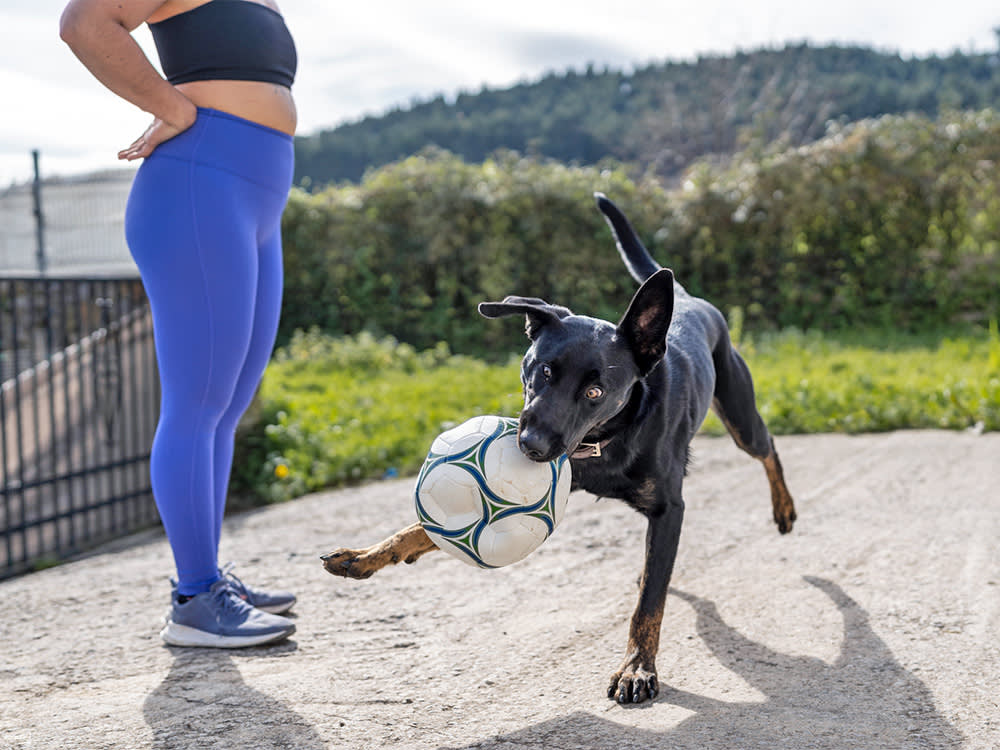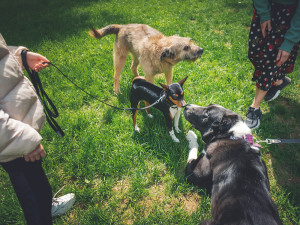20% Of Dogs Show ADHD-Like Traits – Here’s How to Help and Train Them
Got a distracted pup? Discover if it’s ADHD and how to help

Share Article
Have you met Nemo? The goofy, enthusiastic Labrador who can open the fridge to pass you some juice, yet hasn’t quite got what it takes to pass assistance dog exams. Nemo has a starring role in the recent Netflix dog-umentaryopens in a new tab that explores Inside the Mind of a Dog. He is presented as one of the around 20 percent of dogsopens in a new tab that recent studiesopens in a new tab suggest may exhibit symptoms similar to Attention Deficit Hyperactivity Disorder (ADHD) in humans.
While dogs have long been trained to assist people with ADHDopens in a new tab, research is now turning the spotlight on the dogs themselves. These studies explore hyperactivity, impulsiveness and attention-related issues in our canine companions, shedding light on sometimes challenging behaviours that can impact daily life.

littleKin™ is Kinship’s home just for puppy and kitten parents. Bop over to check out expert advice, new pet tools, and special deals—all curated for your newest family member.
opens in a new tabThe research into ADHD-like symptoms in dogs is opening up new conversations about how to better support dogs with these behaviours, which – as we well know – will ultimately look to improve the well-being of dogs and their families.
What does ADHD in dogs look like?
Whilst ADHD in dogs hasn’t got an official diagnosis as it does in humans, our canine companions can display many similar behaviours to those recognised in the human condition – including hyperactivity, impulsivity and an inability to remain focussed.
Symptoms of the disorder manifest through behaviours such as excessive barkingopens in a new tab, restlessness, difficulty focusing, destructiveness, ill-ease at being left aloneopens in a new tab and trouble following cues. These traits can vary widely among dogs depending on factors like breed, age, sex, body size and environment.
Is my dog displaying ADHD-like traits?
Understanding your dog’s behaviour requires a holistic approach. We need to look at a wide range of factors such as their general health and wellbeing, the quality of exercise and rest they’re getting, how much interaction and stimulation they receive, and of course their age and stage of development.
Tracking your dog’s behaviour over a couple of weeks can be invaluable to start to understand why they’re behaving the way they are. Writing down their level of hyperactivity or anxiousness, amount of rest received in a 24-hour period, and any examples of activity or disturbance they’ve experienced can start to carve out a pattern of data. This allows you to see if hyper or inattentive behaviours are a regular occurrence – part of your dog’s personalityopens in a new tab or potential disorder – or if they’re a one-off repercussion of too much excitement or negative stimulation, for example.
If your dog’s behaviour has recently changed, it’s vital they’re assessed by a professional veterinarian to rule out any illness or painopens in a new tab. A full blood panel can highlight problems such as thyroid issues, vitamin B deficiencies or other conditions that can impact behaviour. Support from an ethical dog behaviouristopens in a new tab will also help you in dealing with any of the challenges your dog may be displaying.
How to diagnose ADHD in dogs: professional assessment and tests
As one studyopens in a new tab discusses, “ADHD has a very complex pathophysiology in which many neurotransmitters are involved, such as serotonin and dopamine”. Conducted at the Santiago de Compostela University, the study’s researchersopens in a new tab found that “dogs clinically classified as ADHD-like showed lower serotonin and dopamine concentrations”.
Serotonin is known as the ‘feel good’ hormone, while dopamine is the happy hormone. “Serotonin and dopamine levels were also linked to aggression, hyperactivity and impulsivity,” the study revealed. “Decreased serotonin concentrationsopens in a new tab were also related to fear, attachment and touch sensitivity.”
As a Certified Animal Behaviouristopens in a new tab, specialising in dogs, I understand how these ADHD-like traits can cause huge disruption for dogs and their humans. Behavioural challenges are listed as one of the top reasons young dogs are surrendered to rescue centresopens in a new tab. This is why it’s so vital that if you see any signs of your dog struggling with their emotional wellbeing that you reach out for support from your vet and an ethical behaviourist at the earliest opportunity.
Dog behaviours that prove challenging shouldn’t immediately be attributed to being an ADHD-like trait. There are several other explanations for your dog’s behaviour that could be at play; it could be that they’re struggling with too much – or not enough – stimulation, exercise or enrichment, which is why we need to look at the whole picture. As one study explainsopens in a new tab, “in some cases, high levels of hyperactivity/impulsivity and inattention may be due to limited possibilities to release energy and reduce activity levels”.
Dogs have unique needs, both at a breed level and at an individual level; there’s so much that goes into how our dogs behave – both from a genetic (nature) and environmental (nurture) perspective. However, when you’re living with a dog who finds it hard to take on new learning or show calm behaviours – it can be difficult to determine how to let them have the right outlet for their specific level of energy. That’s why having a professional guide you through the process can be so valuable.
Training tips for hyperactive dogs with ADHD-like traits
Whilst it can be tempting to try to tire out a dog that’s acting in a hyperactive manner, sometimes less is more! Aim to keep a balance in your dog’s week – with regular shorter training sessions, combined with calming enrichment activities like scentwork, regular exercise and quality sleepopens in a new tab.
If your dog finds training frustrating, start simple. Write down a training plan at the start of a session, so you know exactly how you’re going to build up the steps of the exercise. If your dog shows signs of getting frustrated – barking, jumping up, grabbing onto clothing or shutting down – then stop. Give your dog a break then try at a slightly easier level later in the day.
Activities and exercises to calm hyperactive dogs
Research at the University of Helsinkiopens in a new tab suggested “a substantial genetic basis for these traits”. They looked at a variety of breeds including working breeds such as the German Shepherd, Border Collie and Cairn Terrier. Working dogs have been bred to be highly active and when placed in a pet home, without the right sort of activity or stimulation, may be more likely to show the traits of hyperactivity and impulsivity. Engaging in dog sports such as working trials, hoopers, agilityopens in a new tab or flyballopens in a new tab gives you a way to provide an outlet for natural breed desiresopens in a new tab.
Scentwork is also a great way to calm any dog of any age, as well as giving them an amazing opportunity to use their natural instincts. Whether you go for food scatters in the garden, learning a new skill like mantrailingopens in a new tab or hiding scented items around your house for your dog to seek out, the simple act of sniffing has been proven to lower pulse rateopens in a new tab as well as increasing the important feel-good hormone production of serotonin and dopamine.
Supporting your dog with ADHD-like traits: veterinary and behavioural interventions
Dogs displaying any of the ADHD-like traits we’ve discussed require understanding and support. Labelling a dog that’s struggling behaviourally simply as ‘bad’ or ‘untrainable’ will limit the progress that can be made. It’s important to remember that these behaviours may indicate underlying issues that can be addressed with appropriate veterinary and behavioural support. Being proactive as soon as any of the traits are displayed is also crucial to helping your dog. Working to support both ends of the lead, with an ethical behaviour practitioner alongside your vet, can ensure that dogs with ADHD-like behaviours receive the care they need to thrive.
Resources:

Caroline Wilkinson
Caroline Wilkinson is a Certified Animal Behaviourist. As the Founder of digital pet coaching service Barket Place, Caroline has a passion for improving connections between human and hound, with a focus on relationships and reduction of stress for canines living in a human world.
Related articles
![Dog looking at their shadow in the snow]() opens in a new tab
opens in a new tab“Why Is My Dog Obsessed With Chasing Shadows?”
A fascination with lights and shadows is common in high-energy dogs – but it can develop into obsessive-compulsive disorder if it gets out of hand
![Pet parent comforting anxious dog by holding their paw]() opens in a new tab
opens in a new tab8 Tips for Helping an Anxious Dog
Easy ways to calm your pup’s nerves
![Three dogs on leashes meeting and sniffing each other on a walk on the summer grass with owners]()
How Do I Get My Shy Dog To Socialise?
Dog trainer Robert Haussmann’s tips for getting a shy pup to go from wallflower to social butterfly
![girl with blue hair starting puppy training with white dog]() opens in a new tab
opens in a new tabPuppy Training 101: How to Train a Puppy
You and your cute classmate have lots to learn







